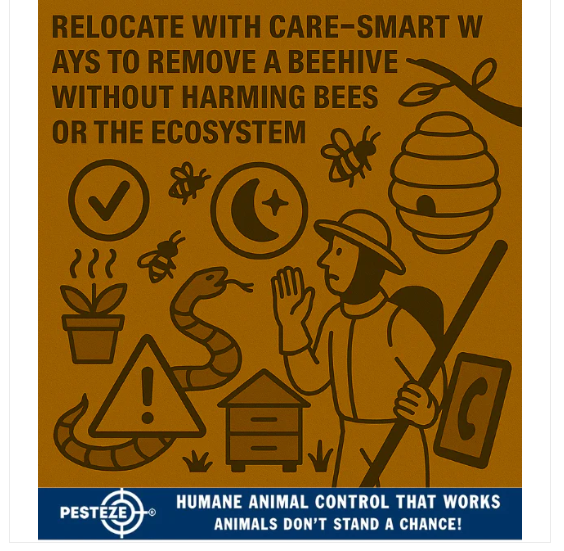HOW TO GET RID OF A BEEHIVE WITHOUT HARMING BEES

HOW TO GET RID OF A BEEHIVE WITHOUT HARMING BEES
SUMMARY
Bees are vital pollinators, but a beehive too close to your home or workspace can pose safety risks. Instead of extermination, humane removal protects both people and pollinators. This guide outlines safe, eco-friendly methods to relocate a hive without harming the bees or disrupting their colony.
FEATURES
-
Identify the Hive Type: Determine if it’s a honeybee colony, solitary nest, or wasp hive before taking action.
-
Call a Local Beekeeper: Professionals can safely remove and relocate hives to suitable environments.
-
Use Natural Deterrents: Scents like citronella, peppermint, and cinnamon can encourage bees to move.
-
Avoid DIY Removal: Untrained handling can provoke aggression and damage the hive structure.
-
Relocate at Night: Bees are less active after sunset, making removal safer and less stressful.
-
Prevent Future Nesting: Seal entry points and reduce attractants like standing water and flowering weeds.
GUIDE DESCRIPTION
Finding a beehive near your home or barn can be alarming—but it doesn’t mean the bees have to be harmed. Bees play a crucial role in pollination and biodiversity, so humane removal is the responsible choice. With the right approach, you can relocate a hive safely and sustainably.
Start by identifying the hive. Not all buzzing insects are bees—some may be wasps or hornets, which require different handling. Honeybee colonies are typically found in wall cavities, tree hollows, or under eaves, and they’re more docile than other stinging insects.
The best option is to contact a local beekeeper or humane bee removal specialist. Many beekeepers will relocate hives for free or a small fee, especially if the colony is healthy. They have the tools and experience to move the hive without harming the bees or damaging property.
Natural deterrents can help encourage bees to leave on their own. Scents like citronella, peppermint, garlic, and cinnamon are unpleasant to bees and may prompt them to relocate. These methods are most effective for small or newly formed hives.
Avoid DIY removal unless you’re trained. Disturbing a hive can provoke defensive behavior and lead to stings or colony collapse. If removal is necessary, it should be done at night when bees are less active and easier to handle.
Once the hive is removed, take steps to prevent future nesting. Seal cracks, holes, and cavities in walls or roofs. Remove standing water and trim flowering weeds that attract bees. Consider installing bee-repelling plants like eucalyptus or lemongrass.
By choosing humane methods, you protect both your space and the bees—ensuring safety and ecological balance.
- Amy Chang


Comments 0